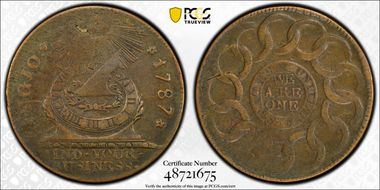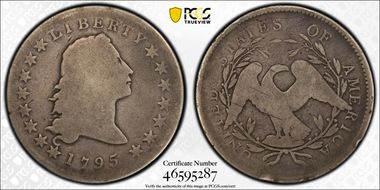jackpine20 的钱币相册
Today, November 5th, 2024 is presidential election day in America! In honor of this highly consequential ritual, I thought I would share a copper coin from our pre-pubescent republic. This attractive, yet often overlooked 1787 Fugio Cent (Newman 13-N variety, Rarity-5) represents the first federally issued design authorized by The Congress of the Confederation of the United States, pre-dating all others, even the widely circulated Flowing Hair Large Cent of 1793 and later. By most accounts, the Fugio Cent was designed by Benjamin Franklin. Early dealers and collectors advertised the availability of what they then called, the Franklin Cent. Not surprisingly, the coin's design shares elements consistent with paper currency printed years earlier on one of Franklin's printing presses. ~~~~~~~~~~~~~~~ On the obverse, FUGIO translates from Latin, "I flee", referring to the passage of time, implicit in the design's radiant sun and sundial. My favorite part, MIND YOUR BUSINESS can be read literally, as Franklin was known to have strong opinions on the matter. Aptly applied to our current presidential contest, an entry in the Journal of Congress dated September 30, 1788 reads in part, " The excellent monitorial caution, MIND YOUR BUSINESS, impressed on each of these, may prove an antidote to insurgency." Time will tell. ~~~~~~~~~~~ On the reverse, we find thirteen interlocking rings representing the original thirteen colonies, together surrounding the motto, WE ARE ONE. That's not such a scary thought.
This plain edge large cent is part of my lowball set - all dated 1795. I cracked it out soon after purchase because the dandruff inside the holder bothered me too much, smh. In time, when PCGS gets a better grip on their TrueView quality control, I will re-submit. Sadly, 'washed-out rust' appears to be the default camera setting for copper. There are countless other examples, many worse than mine, of disappointing TrueView images that have entered the public domain in 2024 and 2025. If PCGS is using Artificial Intelligence in the photo lab, someone needs to pull the plug on that and return to what we all agreed upon was beautiful numismatic photography.
This plain edge large cent is part of my lowball set - all dated 1795. I cracked it out soon after purchase because the dandruff inside the holder bothered me too much, smh. In time, when PCGS gets a better grip on their TrueView quality control, I will re-submit. Sadly, 'washed-out rust' appears to be the default camera setting for copper. There are countless other examples, many worse than mine, of disappointing TrueView images that have entered the public domain in 2024 and 2025. If PCGS is using Artificial Intelligence in the photo lab, someone needs to pull the plug on that and return to what we all agreed upon was beautiful numismatic photography.
I was thinking, wouldn't it be satisfying to re-unite specimens of the Randall Hoard, all in PCGS Generation-1 holders? This charming example is my first. Quoting from Q. David Bowers' chapter on the subject, "It seems to be the consensus that a small wooden keg filled with uncirculated copper cents was found beneath a railroad station platform in Georgia after the Civil War, but before autumn, 1869." The Georgia merchant who discovered the hoard was John Randall; hence, the name. Five thousand to ten thousand uncirculated, copper Coronet Cents dated 1816, 1817, 1818, 1819, and 1820 are believed to be among the coins found, making these years somewhat more available in Mint State. As an N-10 variety, I believe this coin was part of the hoard.
Overton 119, R.3 Pointed 6, Stem. Q. David Bowers' book, "Lost and Found, Coin Hoards and Treasures" is an amazing volume, well worth your time. In the chapter devoted to The Economite Hoard, he writes of a significant stockpile of eleven boxes of silver coins, with a face value of $75,000, consisting mostly of half dollars, sealed up in three brick vaults some time around 1836 by a celibate Christian community, perhaps cult, known as The Harmony Society of Economy, Pennsylvania. Specimens from the hoard were later documented - dated 1794 to 1836. Stored inside the damp, basement vaults were 400 quarter dollars, 116,000 half dollars, and over 3,000 silver dollars. The ensuing four decades of exposure to the moist humidity in the vaults led to the darkening of the silver. With that in mind, I believe some of my cherished, darker specimens, including this one, may share in this common historic context. The many thousands of silver coins were dispersed to collectors and dealers soon after the vaults were emptied in 1878. A great fraction of The Economite Hoard was sold at a small premium, to numismatist, Captain John W. Hazeltine. He, in turn, catalogued and published in 1881, his type table, differentiating many newly discovered half dollar varieties; mine is common. I am fortunate to have acquired via eBay, a 1927 reprint (by numismatist Max Mehl) of the original 1881 Hazeltine Type Table Catalog of quarter dollars, half dollars, and silver dollars.
In what became known as the 'Genesis Letter', addressed to the Secretary of the Treasury, dated December 27, 1904, President Theodore Roosevelt wrote, "My dear Secretary Shaw: I think our coinage is artistically of atrocious hideousness. Would it be possible, without asking the permission of Congress, to employ a man like St Gaudens to give us a coinage that would have some beauty? Sincerely yours, Theodore Roosevelt." ~~~~~~~~~~~~ Soon thereafter, sculptor Saint-Gaudens and President Roosevelt collaborated on a vibrantly creative project to re-design all of the denominations of United States coinage, starting in 1907 with this $20 gold coin, known today as the Saint-Gaudens gold double eagle. Sadly, however, while early design elements of the coin were still being worked out, the artist succumbed to cancer on August 3, 1907. The Genesis Letter, referenced here, was passed down through the heirs of Secretary Shaw, ultimately changing hands in an August 3, 2012 Heritage Auction where the letter brought a noteworthy $94,000.
Overton 115, R.5 I was waiting behind someone at US Coins in Houston, Texas, peering through the glass counter, when I noticed it from a distance. I was smitten from the start! Protected in a desirable generation 4.4 holder, the coin has an aesthetic that would make Robert Scot smile! Remember, think like an artist, not an accountant. footnote: The TrueView image is perfect! PCGS photographed the coin without removing it from the holder, so I could experience the TrueView of this little jewel in all its glory. That was kind of them.
Overton 105, R.1 A dealer told me one time, when I showed interest, that some people use the words ‘grey dirt’ to describe the attractive, darker toning on some early silver coins. I repeated his words, years later, when I pulled the trigger on this stunning example. Purchased raw, via eBay.
B-1, BB-21, 2 Leaves Variety, R.2 Curious as I was, I cracked it out! Protected now in an Air-Tite holder, I hide it away inside the bowels of my antique Victor safe. I have a private ritual. Periodically, on special holy days, I love to pull it out and hold it in my hand, to study it raw, the way Robert Scot intended. All this, while sitting at my mid-eighteenth-century figured maple writing desk, dovetailed for both strength and beauty. Amazed! I sit transfixed. Then, I put it back. Amen.
B-17, BB-101, 5 Lines, Pointed 9, R.5 EX: The Palos Verdes Collection sold via Heritage in January, 2017. This scarce variety is described on page 39 of my 1950 first edition of M. H. Bolender's book, "The United States Early Silver Dollars, From 1794 to 1803". Quoting, now: "1798 B-17 (H-17) Excessively rare. Hazeltine's was only good, the only one he ever found. The author's (Bolender) is fine, and the only one he has seen. Rarity 7." There is a chance that my example was a part of something called The Economite Hoard, due in large part to the dark toning consistent with those many tens of thousands of silver coins, mostly half dollars, in that stockpile, dated 1794 to 1836. A great portion of the cache, including early silver dollars, was sold to the prominent numismatic dealer and cataloger, Captain John W. Hazeltine soon after discovery in 1878. I like to imagine my well worn dollar was part of that Hazeltine trade, leading then, to his cataloged public auction, in 1881, of this very rare Hazeltine variety, H-17. Later, B-17, BB-101. Note: The coin’s value has doubled in the last three years, from $1500 (2021) to $3000 (2024).
B-2, BB-143, 13 Reverse Stars, R.4 VG Details. Study the handsome inscription on this 1799/8 Draped Bust Dollar: ( H.D. Henderickson - Presented by - Wm. Bradley - of New York ). I was the sole bidder in an eBay auction in November 2021. The raw coin was listed as engraved, not a love token, so I suspect many in that target audience were missed. I did a little genealogy search and found one William F. Bradley b.1857, d.1939 in Queens, New York, listed as Single, perhaps never married. H. D. Henderickson was harder to locate. The surname is spelled in such a way as to suggest it might be a first or second-generation Swedish immigrant. I know it's a long shot, but I found an H. Henderickson b.1858 in Sweden, who farmed in Polk County, Minnesota. ******************************* An alternate possibility may be William Bradley (1852-1924). Paraphrasing this particular fellow's 1924 obituary and other documents: "Mr. Bradley began with barely a high school education and a first job hauling dirt. Fast forward as his hard work and fame grew over time, both as a trotter-horse trader, and also as a large stockholder in a horse dealing firm that handled 50,000 to 100,000 work horses per year. In time, he succeeded as the owner of one of the largest excavation companies in New York, called Bradley Contracting Company. In New York City, Bradley built the greater part of the subways, cleared the streets of New York of snow under a favored Tammany Contract for many years, bored the Peacock Mountain tunnel for New York's water supply, built the Homestead tunnel for the Pennsylvania Railroad, kept 8000 men and 2000 horses on one tunnel job for more than a year, made contracts in tens of millions and at one time made claims against the city of New York for over $6 million." [sidenote: the first subway in NYC was completed in 1904] His obituary continues, "When Bradley died, he was at the end of a long struggle over contracts that cost him millions through strikes and business troubles, rising costs due to the war, and an inability to wield his mighty political influence, that had previously enabled him to go ahead with some of the greatest contracts, gifts of New York City. In the end, Bradley faced receiverships and bankruptcies, and finally died with only a few hundred dollars to leave to his widow." **************************** It would be convenient if his widow's name were something like Helen D. Henderickson, but my genealogy search uncovered only the name Cecelia Bradley. No maiden name was given. What if the engraved initials, H. D. were those of a young Swedish laborer born, Henry David Henderickson employed by Wm. Bradley to haul dirt?






























